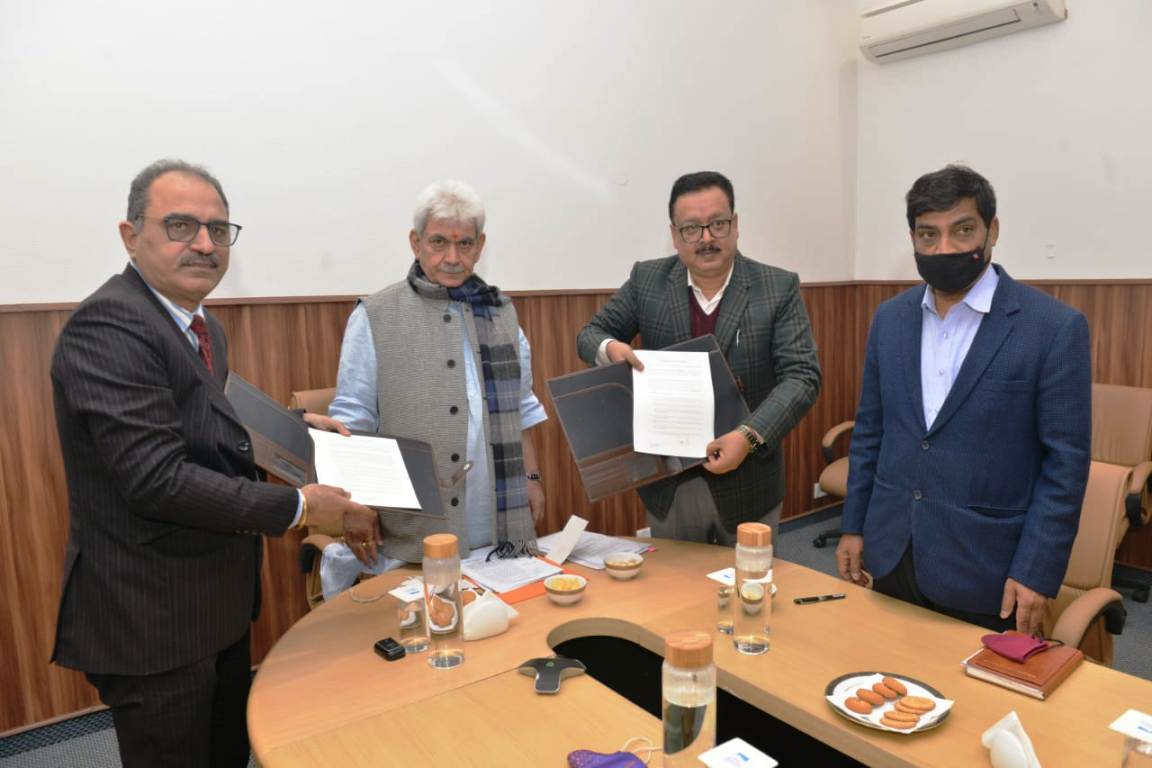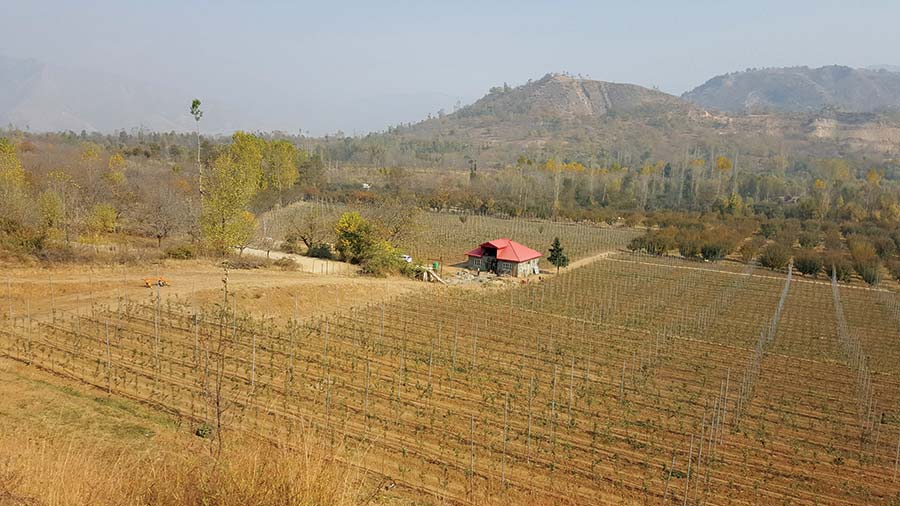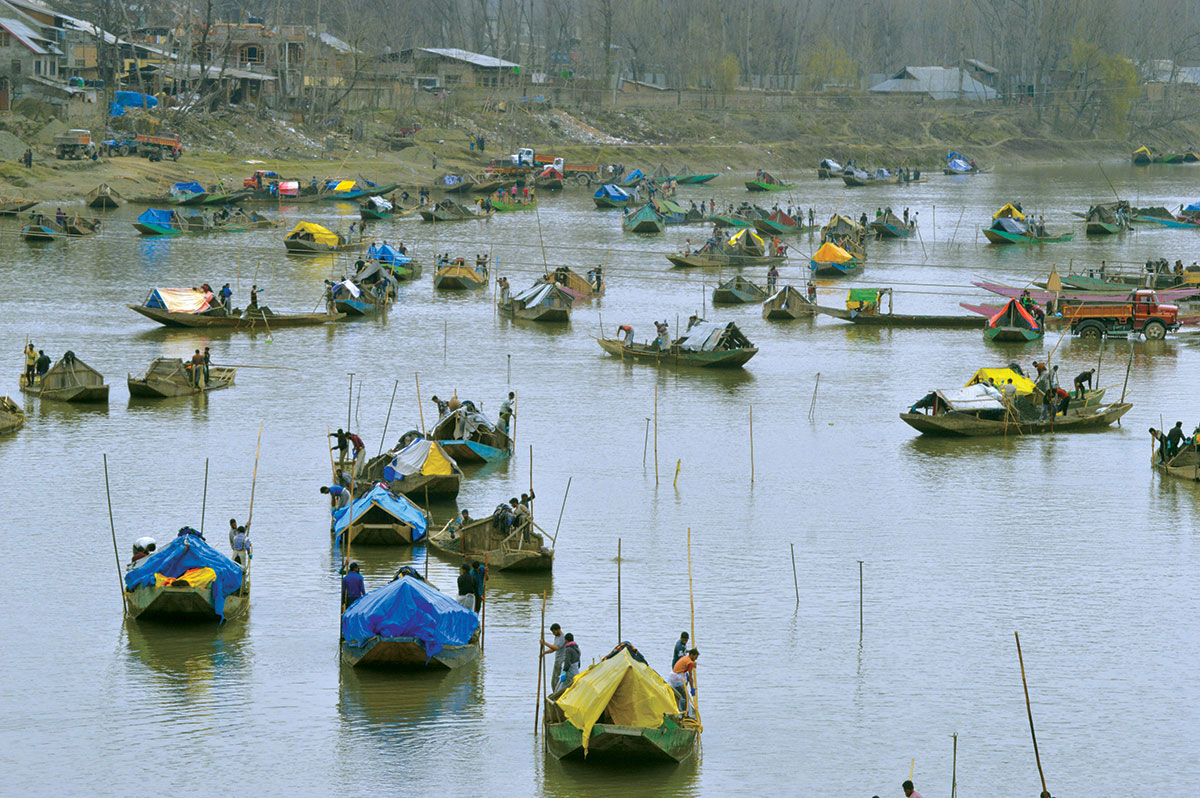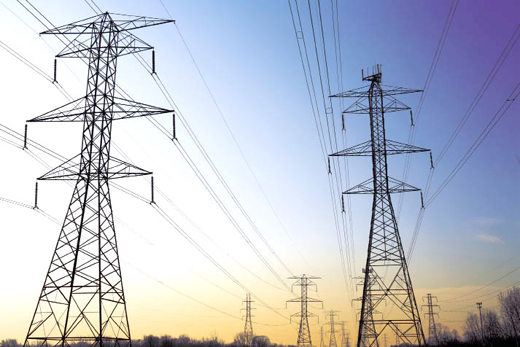The Naya Kashmir of the twenty-first century is “by the corporation, of the corporation, and for the corporations”, writes Haseeb A Drabu

After decisively changing the political structure of Jammu and Kashmir, the union government has now shifted gears to focus on the economy. Considering that the Parliament was informed that Article 370 and Article 35A were abolished to remove the roadblocks to the economic development of Kashmir, the slew of economic policy measure announced over the last three months were expected for some time now.
There is no denying the fact that BJP is transforming the nation-state from an accommodating (read, “soft state”) to a hard state, more so vis-a-vis Kashmir. What this meant in political terms has already been seen. On the economy front, the intention seems to be to replace the “granny state which doles out goodies” by a hardnosed development state which gets a bang for every buck. No quarrels with that.
Private To Public
At the time of abrogation, it was announced that Kashmir had now been opened up to private investors, especially the domestic corporates. A year later, the almost daily policy pronouncements over the last three months indicate that it is not the private corporate sector but the central government-owned public enterprises that are leading the development mission. The difference is important as it reflects a big shift in the underlying economic strategy.
To be fair, post-January, 2020, the pandemic has put a huge spanner in the investment plans right across the country and indeed the world. So it is far-fetched to expect domestic corporates to make an investment in Kashmir now. For sure, some of the lull in the private investment sentiment has to do with the fact that in the pandemic pulverised world where the Indian economy is seeing new lows every day. The latest estimates of GDP show a 7.7 per cent drop which is the steepest fall in the economic history of post-independent India.
Not that one hadn’t expected much in any case. As it turned out, there has not been any private investment interest even in the period between abrogation and the onset of the pandemic. Ferrying a planeload of central ministers over a weekend and having a few road-shows run by bureaucrats do not seem to have whetted the appetite of India Inc.

Perhaps, in view of this, a course correction has been made; the old warhorses have been called into play. The local ones like the Jammu and Kashmir Industrial Development Corporation (JKIDC) has been given a brand new set of teeth, making it even more powerful than the UT administration itself. A new industrial package announced with much fanfare revolves around the land bank that this corporation essentially is.
The national veterans like National Hydro Power Corporation (NHPC) were granted a virtual monopoly over the waters of Kashmir.
Similarly, the National Agricultural Cooperative Marketing Federation of India (NAFED) another central public sector undertaking (CPSU) without much to show for its performance over the last sixty years of its existence, has been given serious play in the prime income-generating sector of horticulture. It is to invest primarily in the post-harvest storage infrastructure and distribution network which is where maximum local private investment has been made over the last five years or so.
Two Questions
In order to assess this PSU led development strategy for Kashmir, two questions need to be asked. First, is it in line with the national economic policy pursued by this government across the country? The answer is a resounding no. If anything, it is quite a contra to the national macroeconomic strategy. As of today, the government of India plans to completely exit non-strategic sectors through privatisation or strategic disinvestment. It aims to retain only a few public-sector units in strategic sectors that might include defence, banking and insurance, petroleum, steel and fertilisers. The Centre is committed to raising Rs 1.2 lakh crore in the current fiscal through the strategic sale. In addition, another Rs 90,000 crore from disinvestment of the stake in the CPSUs taking the total to more than Rs 2 lakh crore of sale.
Second, is what has been the track record of the CPSUs in erstwhile J&K? The answer in one word is dismal. The 300 odd Central PSUs that have investments of about Rs 25 lakh crore, and employing more than a million people across the country have invested a paltry sum of Rs 150 crore in Jammu and Kashmir. And these large companies collectively employed only 21 people in the erstwhile state. To be sure these central government-owned companies faced no Article 370 or Article 35A barriers.

The dismal aggregate performance of the CPSUs in Kashmir apart, there is not a single example worth emulating at the micro-level. Not so long ago, in 2008, state-run steel giant SAIL was given land in Lassipora, Pulwama to set up a steel processing unit (SPU) at the cost of about Rs 100 crore. The SPU was slated to have an initial capacity of 1 lakh tonne annually and was to produce TMT bars and galvanised corrugated sheets. In 2011, SAIL unilaterally abandoned the project even as the land probably still stands allotted to it.. There are similar stories associated with many CPSUs.
Finger In Every Power Pie
This apathy is not restricted to manufacturing enterprises only. Even banks and financial institutions have the same mindset. All the PSU banks which had a good presence across Jammu and Kashmir– State Bank of India, Punjab National Bank, Central Bank or Dena bank — were all content with accepting deposits but not lending in Kashmir. Their credit-deposit ratio, often in single digits, became a political issue. In fact, PSU banks behaved like deposit-taking non-bank finance companies in Kashmir.
But, it is NHPC that literally takes the cake. If there is one CPSU that is a bad word in the lexicon of the autonomist intellectuals of Kashmir, it is NHPC. It has exemplified Government of India’s approach to the economy of Jammu and Kashmir; apparently palliative but basically exploitative.

With eight projects of about 2300 MW under its control in the erstwhile state – Salal, Uri I and II, Dulhasti, Sewa, Nimu Bazgao, Chutak and Kishenganga, more than half of NHPC’s hydropower generation is from Kashmir waters. The valley based projects account from 47 per cent of the power generation with Kashmir getting next to nothing benefit. From the audited accounts of the publicly listed company, it was been estimated a few years back that NHPC gets around Rs 16,000 crore revenues from the sale of power generated by harvesting the Kashmir waters. Even though this is a gross underestimate, it still compares exceptionally well with Rs 15,000 odd crores that NHPC has invested in Kashmir hydro projects over the last thirty years. In fiscal 2019-20, NHPC sold energy worth Rs 8301 crore.
Now, under the latest arrangement, all the remaining power projects have also been handed over to NHPC. Last week, memoranda of understanding (MoUs) were signed with NHPC, to attract investments worth Rs 35,000 crore. It is not entirely clear as to whether this is the promoters’ equity that is being talked about or does it also includes the debt that will be contracted for building the hydropower projects. If the past is something to go by, this is reminiscent of the Rs 24,000 package announced by Dr Manmohan Singh in 2005, of which Rs 18,000 crores were earmarked for power in Jammu and Kashmir. It later transpired that this was the equity contribution of the Government of India for NHPC’s power projects!

While the first time hydropower projects were gifted to NHPC by the democratically elected government of Farooq Abdullah in 1996, the experience was so bad that in 2008, 49 per cent of the projects were got back from NHPC through a joint venture with a Chenab Valley Power Projects (CVPP) where Jammu and Kashmir had a 40 per cent equity stake. Indeed, the MoU that has been signed by the unelected administration was rejected by the regional parties earlier.
It is not clear as to why these projects were not done by CVVP which would have given Kashmir a stake in the projects and not just 12 per cent power free; dividends would have up-streamed to the government had this route been taken. Equally significant is the future of Jammu and Kashmir SPDC. The candidate for public listing is going to wither away over time.
As it stands now, NHPC, directly and through its joint venture with Chenab Valley Power Projects, has a finger on every power pie of Kashmir. The access to such unexploited power has already seen a movement in the share price of NHPC last week. There is surely going to be an increase in the market valuation of NHPC.
An Apple A Day
The same model has now been extended to the horticulture sector. The Union government has now got in National Agricultural Cooperative Federation (NAFED) of India to buy 12 lakh tonnes of apples in Jammu and Kashmir this year. Even though the same scheme flopped when it was introduced last year, managing to procure only about one per cent of its target. On January 1, 2021, the NAFED signed an MoU with J&K in this regard.

Besides putting a large corporate in direct competition with the local investors, this intervention will have a hugely debilitating impact on trade which is the precursor of trust, of bonds, of livelihood and shared prosperity. The apple growers of Shopian and the commissioning agents of Azadpur have for decades shared good times and survived bad times together. These have proved to be the strongest linkages between Kashmir and the rest of the country. It is these that are now getting effected. It will not only make the valley even more insular, economically but will isolate it politically as well.
The net result is that local businesses have assets that they can’t sweat. Nor can these be leveraged by them because of credit limits being under stress. Their inventories will now have to be liquidated or monetised through CPSUs which has market dominance. In short, the “steady-state” dynamics of the Kashmir economy has been disrupted and the inter-related microeconomic decisions being made post the exogenous political shock is more likely than not to put all commercial activities – industrial, artisanal, trade or agricultural — in a low-level equilibrium trap. The economy will regress not just in growth but structure too.
New Economic Strategy
Up until now, the government was only intervening in the factors market of the Kashmir economy; now it has taken the responsibility of the product markets as well. Even at the heights of public sector in India, it invested only in the production sphere. In Jammu and Kashmir, it has only functioned in the consumption sphere and now is into distribution, let alone production.
Now all the major economic activity will now be he corporations, of the government for the corporations. That’s the new model of economic development.

This will result in a series of sequential changes down the line; a shift from self-employed to wage labour is the most obvious one. Not out of any state coercion but out of market compulsion. It will come across as a rational decision – the Kashmiri farmer will choose wage work because of a higher wage. In the process he will get alienated, if not expropriated, from his land. The small, medium and micro enterprises will also face a similar fate.
In this new model the local businessman and entrepreneur — small land owners, self-employed in horticulture, and owners of commercial trade enterprises – will face serious business competition and challenges. This will in turn have social implications. The business fraternity in the valley that emerged in a regulated quasi-protected economy will have to reinvent itself if it has to survive. Till now, local businesses, working with the state PSU’s like SIDCO and SICOP, kept their bottom lines black making the extra buck from subsidies, reservations, quotas and arbitrage. They will now be faced with market forces that are not associates by adversaries.
From Business Associate To Market Adversary
A case in point is the setting up of a Jammu and Kashmir Industrial Development Corporation (JKIDC). Ostensibly created for “the rapid and orderly establishment, and organisation of industries in “industrial areas and industrial estates”, it has near monopoly rights to “acquire” and “hold” “property, both movable and immovable” and “lease, sell, exchange or otherwise, transfer any property held by it”.
Beyond these land-bank powers, the JKIDC has been given vast powers virtually making it a state unto itself; state within a UT. In the matters of land, the JKIDC is even more powerful than the government. The government, for instance, is subservient to the corporation for having to make land available for it to distribute. Even while giving financial support to it, the Government has to consult the corporation on the terms and condition of grants, subventions, loans and advances. All its borrowings, including those in the open market are government guaranteed. Except section 22T, it can even accept deposits. If the Corporation cannot acquire land by agreement, it can use the Government to proceed under the Land Acquisition Rehabilitation and Resettlement Act, 2013 for acquiring it.

The Corporation is so empowered that it can “depute a police officer by written order” to do its bidding. It decisions have been kept out of the purview of even Courts: “no Court shall take cognizance of any offence relating to property belonging or vested by or under this Chapter in the Corporation.”
All this is nothing but the corporatisation of the state, of which NHPC, NAFED and JKIDC are the prototypes. This at a time when nationally, the focus is on divesting in the PSUs and helping the private corporate sector invest and take the economy past the $5 trillion mark. The key is regulation, not a control framework. The strategy is to facilitate not replace. Tragically, as always, exactly the opposite is being done in Kashmir.
(The author, an economist, has been loosely associated with economic policymaking in Jammu and Kashmir since 1996 when he was a member of the Godbole Committee. He was later a member of Prime Minister’s Task Force on long term development strategy for Jammu and Kashmir. As Economic Adviser to two Chief Minister’s, Chairman of J&K Bank and then as Finance Minister he has personally been associated with the policy formulation, developmental negotiations process and implementation.)















